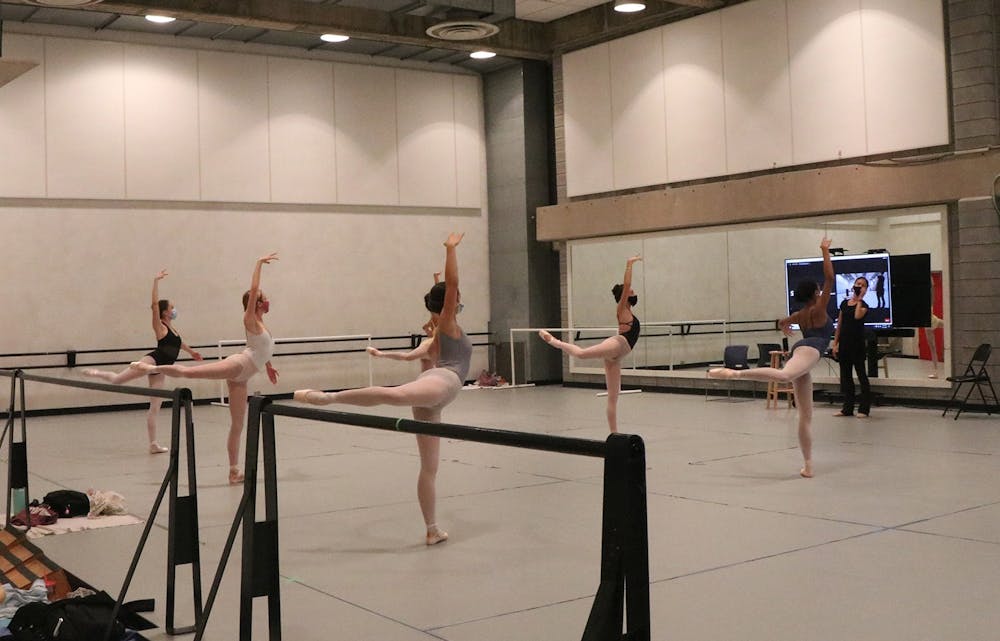IU ballet students were rehearsing for a full-length production of “Cinderella” when IU’s campus closed last spring due to the coronavirus pandemic. Rehearsals for the last performance of the year — and for seniors, their last performance at IU — quickly turned into daily Zoom classes in garages and living rooms, and the show was canceled.
Now, a specialized COVID-19 testing plan is offering some relief for the dancers as the first group of ballet students have resumed in-person training and classes.
IU faculty and officials, including Provost Lauren Robel, Dr. Aaron Carroll and the Restart Committee, have developed a testing plan for students in the ballet department. The plan allows for those in the program to participate in a rotating testing schedule at the Musical Arts Center in which certain groups of students based on class standing will be tested every day for four-week periods. Freshmen and sophomores will receive daily testing in the first four-week period, then juniors, then seniors at the end of the semester. Those being tested all arrive at the MAC every morning at 7 a.m. to ensure that they can stay healthy as they venture into more in-person components of ballet.
“Lauren Robel, as well as Aaron Carroll and the Restart Committee saw and understood our students’ artistic need to train in this contact-heavy manner,” said ballet department chair Sarah Wroth. “Daily testing does not prevent infection, but it — along with masking and assigned partners — will provide an environment in which we have control over the contact involved.”
The faculty in the ballet department have had to adjust to the changes from in-person ballet to virtual. Wroth had never imagined teaching ballet through a computer but said she feels fortunate to still be able to guide the students.
“Never before had I or would I have taught ballet over Zoom, but we are doing it, and we are doing our best to train and inspire these dancers every step of the way,” Wroth said.
Wroth is hopeful the daily testing will allow for dancers to continue their training, particularly in partnering. When the goal is to make a dance appear effortless, there is much needed work between partners. Wroth said she appreciates those who aided in the testing plan for contributing to the dancers’ training and experience.
Wroth also gives credit to the students in the department for keeping each other safe and healthy, creating a collaborative and expressive culture and holding themselves to high standards despite the pandemic limiting their practice of dance.
A significant aspect of the dancers’ training at IU is partnering, also known as a “pas de deux'' said Robert Mack, a senior studying ballet and history with a minor in classics. Students have been unable to practice this “dance of two” since March, which has inhibited their training.
“This has completely upended how we practice and perform,” Mack said. “The dance industry has been hit enormously hard. We used to practice technique, rehearse and perform in person and always in close proximity, and now we’re unable to do repertoire we’ve always done.”
The IU Ballet department typically performs three large-scale performances every year: a fall ballet, The Nutcracker in the winter and a spring ballet. Though these performances have been canceled, Mack said he has found success with the department’s emphasis on other aspects of ballet.
“This has really given us an opportunity to focus on technique more,” Mack said. “We used to really spend our time on the performances, and now we’ve transitioned into focusing on the little things. There’s been a lot of one-on-one time with faculty, which has been wonderful.”
Daisy Ye, a junior studying ballet, spent almost an entire year dancing alone in her basement due to COVID-19 restrictions. But the unyielding work of the students and faculty is opening doors that have been closed by the pandemic, she said.
“It’s tough to have to restrict so many aspects of your life for the sake of the department sometimes, but it’s really paid off and allowed us to continue to dance in person together to some extent,” Ye said.
Dancing and spending so much time together has allowed for those in the department to create fond memories in the past, and Ye is looking forward to the days post-pandemic when she can get back on stage and continue making memories.
“Hopefully, this time in the pandemic has made people realize the importance of art in society,” Ye said. “I would love to see an art boom post-pandemic because I know everyone will be eager to take more risks and live life to its fullest.”
Editor’s note: Robert Mack is a former IDS arts reporter.






